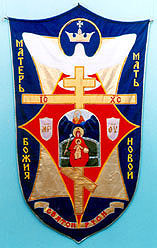
CENTRALIZED RELIGIONS ORGANIZATION
ORTHODOX CHURCH
OF MOTHER OF GOD DERJAVNAYA
From the reference book bey "New Religious Confessions, Movements and Organizations in Russia". For civil servers maintaining contacts with religious organizations, religiologists, journalists and the public-at-large. Russian Academy of Civil Service under the President of the Russian Federation Moscow. 1998, -346 pp.
Ed. by Prof. N.A. Trofimchuk, Doctor of Philosophy; Prof. F.G. Ovsienko, Doctor of Philosophy; and Prof. M.I. Odintsov, Doctor of History.
* * *
"Representing one on the current trends in Russian Orthodox Christianity, the Church recognises the dogmata of Christian Orthodoxy – in particular, the Nicaean-Constantinopolitan Creed – which base on the Scripture, the apostolic tradition and the resolutions of the seven oecumenical councils of the 4th-8th centuries.
It supplements them with the 20th century revelations of the Virgin in Fatima, 1917, Fgypt, 1968-71, Yugoslavia, since 1981, and elsewhere, Russia included. Mariology is prominent in Church theology.
In its doctrine and practice, the Church seeks to revive the tradition of piety and good works going down to Sts. Nilus of Sora, Seraphim of Sarov, John of Kronstadt, and the martyred Royal couple – Emperor Nicholas II and Empress Alexandra, who belong to the most revered saints. The Church is resolutely opposed to the acquisitive pharisaic tradition founded by Joseph of Volotsk. The Church recognises all the seven Holy Sacraments, and bases its worship on the liturgy according to St. John Chrysostom, with inclusions of silent prayer accompanied by gestures. It greatly favours processions. Modern Russian is its accepted liturgical language. Music accompaniment is prominent.
The Church took its source in the Russian Catacomb Church, which did not put up with the godless Bolshevik regime. It was legalised in the early 1990s, and a first community was registered by the federal Justice Ministry, June 1992, under the name of the Church of the Mother of God Transfigured. The Justice Ministry registered it as a centralised religious association of the Mother of God Derjavnaya, February 1997. 17 Russian-based communities had been registered by the start of 1998 – in particular, in the Leningrad and Tver regions and Severodvinsk in the country's north, and Krasnodar and Rostov-on-Don in its south.
There are followers of the Church in more than 200 towns all over the CIS countries. A hundred-strong clergy includes seven bishops. The Church arranges regular councils (sobors), which gather up to 3,500 worshippers from 85 or more cities of Russia and other CIS countries. The Church is ruled by a Bishops' Council, with the seat in Moscow.
Archbishop John, its Primate (Weniamin Bereslavsky in the world, b. 1946), graduated from the Moscow Institute of Foreign Languages in 1970, and embraced Christianity, 1985, to enter the bosom of the Catacomb Church, where he took monastic vows and was ordained priest the same year at a True Orthodox monastery in the Krasnodar Territory. He was chirotonised bishop in Moscow, 1990, with the blessing of Metropolitan John (Bodnarchuk) of the Ukrainian Autocephalous Church.
New Holy Russia Publishers, established seven years ago, has put out over 150 books. 24 issues of the newspaper, The Knight of Faith, came out between 1992 and summer 1995, circulation varying from 10 to 80 thousand. Its name changed to The Virgin's Mercy, another eight issues came out between summer 1995 and September 1997, circulation from 10 to 30 thousand. 16 issues of the magazine, Oasis of Peace, appeared between March 1995 and July 1996, circulation from one to five thousand.
Proceeding from the principle of unity in variety, the Church appeals to other Christian confessions and non-Christian religions for a dialogue. It became fulll member of the International Council of Community Churches under the UN-sponsored World Council of Churches, May 1992.
Archbishop John (Bereslavsky) and the clergy were blessed to witness the Lord on behalf of the Catacomb Church and to have its communities officially registered by Metropolitan Gennadius (Sekach, d. 1985) and Metropolitan Theodosius, his successor to the primacy of the Catacomb Church.
The Church sees practical implementation of the Gospel principle of love of one's neighbour in all fields of life – the family and children's upbringing, domestic and foreign politics, the economy and culture – as the main prerequisite for the revival of Russia. The clergy and the laity widely practise visitation of hospitals, orphanages, prisons and old people's homes on charitable and ritual purposes.
The charitable foundation, The Centre of the Mother of God, was established in 1991. Its name changed to New Holy Russia, 1993. Monastic vows are taken forever or for a term of a year to three years. The Church has several monasteries. The Moscow community has twelve nuns and fifteen monks. The Church possesses a Theological Academy in Moscow with full-time and correspondence departments, and a St. Petersburg branch".
("New Religious Confessions, Movements and Organizations in Russia". For civil servers maintaining contacts with religious organizations, religiologists, journalists and the public-at-large. Russian Academy of Civil Service under the President of the Russian Federation Moscow. 1998, 209-213 p.)
(c) All rights reserved. Oficial site of Centralized religious organization Orthodox Church of Mother of God Derzhavnaya, Moscow, 1999-2007. (c) Fr. Iliya Popov.
You may write to us:mail @ avemaria. ru (without spaces)